automatic transmission Hyundai Genesis 2015 Quick Reference Guide
[x] Cancel search | Manufacturer: HYUNDAI, Model Year: 2015, Model line: Genesis, Model: Hyundai Genesis 2015Pages: 22, PDF Size: 21.37 MB
Page 1 of 22
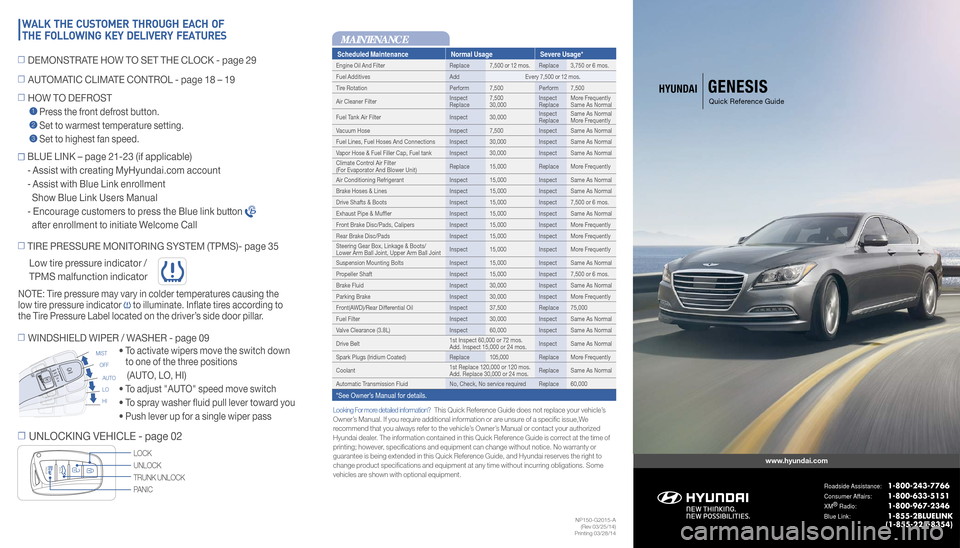
Looking For more detailed information? This Quick Reference Guide does not replace your vehicle’s
Owner’s Manual. If you require additional information or are unsure of a specific issue,We
recommend that you always refer to the vehicle’s Owner’s Manual or contact your authorized
Hyundai dealer. The information contained in this Quick Reference Guide is correct at the time of
printing; however, specifications and equipment can change without notice. No warranty or\
guarantee is being extended in this Quick Reference Guide, and Hyundai reserves the right to
change product specifications and equipment at any time without incurring obligat\
ions. Some
vehicles are shown with optional equipment.
MAINTENANCE
www.hyundai.com
Roadside Assistance: 1-800-243-7766
Consumer Affairs: 1-800-633-5151
XM®
Radio: 1-800-967-2346
Blue Link: 1-855-2BLUELINK
(1-855-225-8354)
Scheduled Maintenance Normal UsageSevere Usage*
Engine Oil And Filter Replace7,500 or 12 mos. Replace 3,750 or 6 mos.
Fuel Additives AddEvery 7,500 or 12 mos.
Tire Rotation Perform 7,500Perform 7,500
Air Cleaner Filter Inspect
Replace7,500
30,000 Inspect
ReplaceMore Frequently
Same As Normal
Fuel Tank Air Filter Inspect 30,000Inspect
ReplaceSame As Normal
More Frequently
Vacuum Hose Inspect 7,500Inspect Same As Normal
Fuel Lines, Fuel Hoses And Connections Inspect 30,000 Inspect Same As Normal
Vapor Hose & Fuel Filler Cap, Fuel tank Inspect 30,000 Inspect Same As Normal
Climate Control Air Filter
(For Evaporator And Blower Unit) Replace 15,000
Replace More Frequently
Air Conditioning Refrigerant Inspect 15,000Inspect Same As Normal
Brake Hoses & Lines Inspect 15,000Inspect Same As Normal
Drive Shafts & Boots Inspect 15,000Inspect 7,500 or 6 mos.
Exhaust Pipe & Muffer Inspect 15,000Inspect Same As Normal
Front Brake Disc/Pads, Calipers Inspect 15,000Inspect More Frequently
Rear Brake Disc/Pads Inspect 15,000Inspect More Frequently
Steering Gear Box, Linkage & Boots/
Lower Arm Ball Joint, Upper Arm Ball Joint Inspect 15,000
Inspect More Frequently
Suspension Mounting Bolts Inspect 15,000Inspect Same As Normal
Propeller Shaft Inspect 15,000Inspect 7,500 or 6 mos.
Brake Fluid Inspect 30,000Inspect Same As Normal
Parking Brake Inspect 30,000Inspect More Frequently
Front(AWD)/Rear Differential Oil Inspect 37,500Replace 75,000
Fuel Filter Inspect 30,000Inspect Same As Normal
Valve Clearance (3.8L) Inspect 60,000Inspect Same As Normal
Drive Belt 1st Inspect 60,000 or 72 mos.
Add. Inspect 15,000 or 24 mos.Inspect Same As Normal
Spark Plugs (Iridium Coated) Replace105,000 Replace More Frequently
Coolant 1st Replace 120,000 or 120 mos.
Add. Replace 30,000 or 24 mos.Replace Same As Normal
Automatic Transmission Fluid No, Check, No service required Replace 60,000
*See Owner’s Manual for details.
�
TIRE PRESSURE MONITORING SYSTEM (TPMS)- page 35
�
UNLOCKING VEHICLE - page 02
• To activate wipers move the switch down
to one of the three positions
(AUTO, LO, HI)
• To adjust "AUTO" speed move switch
• To spray washer fluid pull lever toward you
• Push lever up for a single wiper pass
� WINDSHIELD WIPER / WASHER - page 09
AUTO
LO
HI
MIST
OFF
UNLOCK
TRUNK UNLOCK LOCK
PANIC
NOTE: Tire pressure may vary in colder temperatures causing the
low tire pressure indicator
to illuminate. Inflate tires according to
the Tire Pressure Label located on the driver’s side door pillar.
Low tire pressure indicator /
TPMS malfunction indicator
HYUNDAI GENESIS
Quick Reference Guide� HOW TO DEFROST
1 Press the front defrost button.
2 Set to warmest temperature setting.
3 Set to highest fan speed.
WALK THE CUSTOMER THROUGH EACH OF
THE FOLLOWING KEY DELIVERY FEATURES
� AUTOMATIC CLIMATE CONTROL - page 18 – 19
�
DEMONSTRATE HOW TO SET THE CLOCK - page 29
NP150-G2015-A
(Rev 03/25/14)
Printing 03/28/14
� BLUE LINK – page 21-23 (if applicable)
- Assist with creating MyHyundai.com account
- Assist with Blue Link enrollment
Show Blue Link Users Manual
- Encourage customers to press the Blue link button
after enrollment to initiate Welcome Call
Page 2 of 22
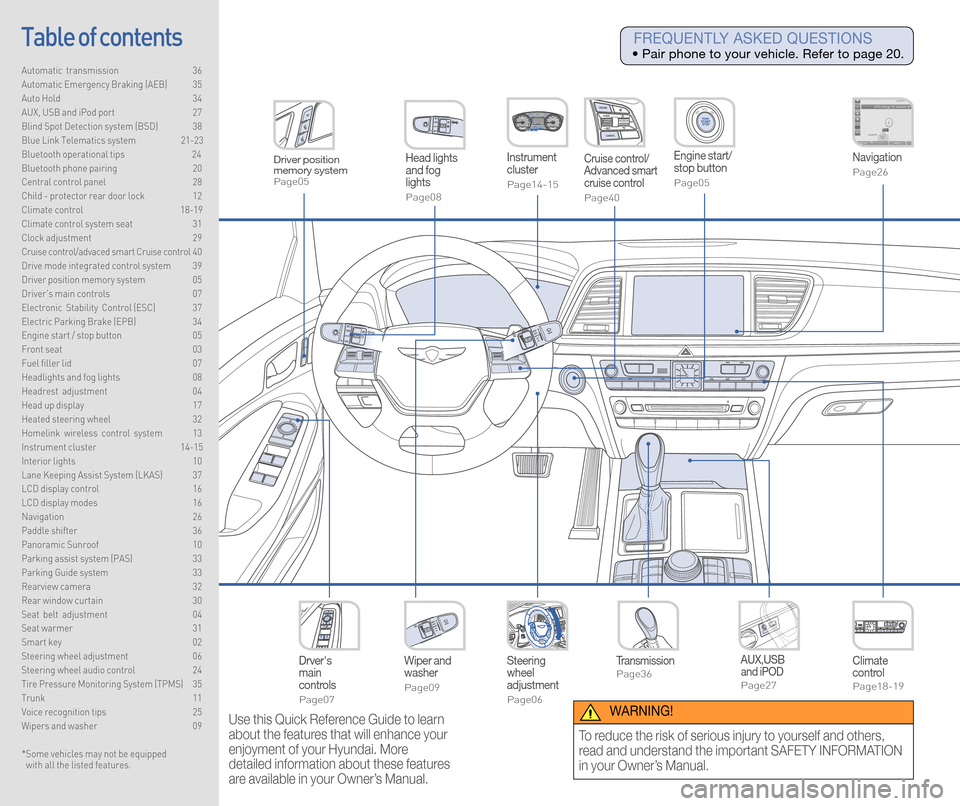
Steering
wheel
adjustment
Page06
Instrument
cluster
Page14-15
Navigation
Page26
Head lights
and fog
lights
Page08
Climate
control
Page18-19
Drver's
main
controls
Page07
Wiper and
washer
Page09
TransmissionPage36
Table of contents
Automatic transmission 36
Automatic Emergency Braking (AEB) 35
Auto Hold 34
AUX, USB and iPod port 27
Blind Spot Detection system (BSD) 38
Blue Link Telematics system 21-23
Bluetooth operational tips 24
Bluetooth phone pairing 20
Central control panel 28
Child - protector rear door lock 12
Climate control 18-19\
Climate control system seat 31
Clock adjustment 29
Cruise control/advaced smart Cruise control 40
Drive mode integrated control system 39
Driver position memory system 05
Driver's main controls 07
Electronic Stability Control (ESC) 37
Electric Parking Brake (EPB) 34
Engine start / stop button 05
Front seat 03
Fuel filler lid 07
Headlights and fog lights 08
Headrest adjustment 04
Head up display 17
Heated steering wheel 32
Homelink wireless control system 13
Instrument cluster 14-15
Interior lights 10
Lane Keeping Assist System (LKAS) 37
LCD display control 16
LCD display modes 16
Navigation 26
Paddle shifter 36
Panoramic Sunroof 10
Parking assist system (PAS) 33
Parking Guide system 33
Rearview camera 32
Rear window curtain 30
Seat belt adjustment 04
Seat warmer 31
Smart key 02
Steering wheel adjustment 06
Steering wheel audio control 24
Tire Pressure Monitoring System (TPMS) 35
Trunk 11
Voice recognition tips 25
Wipers and washer 09
Engine start/
stop button
Page05
Cruise control/
Advanced smart
cruise control
Page40
AUX,USB
and iPOD
Page27
Driver position
memory system
Page05
* Some vehicles may not be equipped
with all the listed features.
Use this Quick Reference Guide to learn
about the features that will enhance your
enjoyment of your Hyundai. More
detailed information about these features
are available in your Owner’s Manual.
FREQUENTLY ASKED QUESTIONS
• Pair phone to your vehicle. Refer to page 20.
WARNING!
To reduce the risk of serious injury to yourself and others,
read and understand the important SAFETY INFORMATION
in your Owner’s Manual.
Page 18 of 22
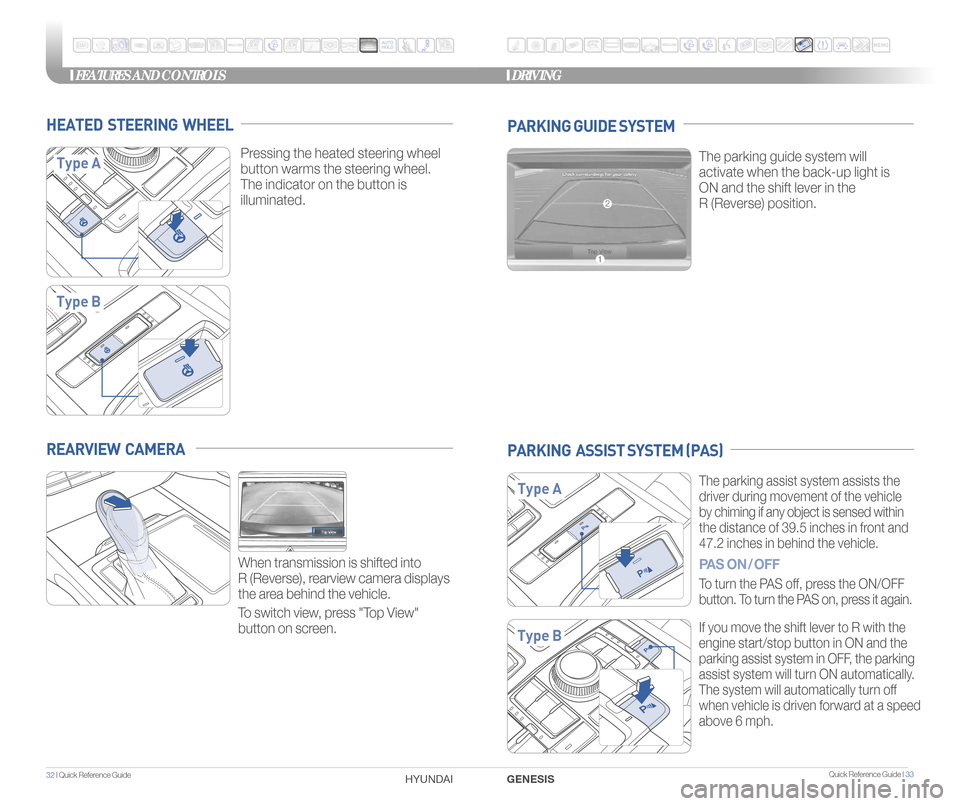
Quick Reference Guide I 33
FEATURES AND CONTROLSDRIVING
32 I Quick Reference Guide GENESIS
HYUNDAI
PARKING GUIDE SYSTEM
The parking guide system will
activate when the back-up light is
ON and the shift lever in the
R (Reverse) position.
PARKING ASSIST SYSTEM (PAS)
The parking assist system assists the
driver during movement of the vehicle
by chiming if any object is sensed within
the distance of 39.5 inches in front and
47.2 inches in behind the vehicle.
PAS ON / OFF
To turn the PAS off, press the ON/OFF
button. To turn the PAS on, press it again.
If you move the shift lever to R with the
engine start/stop button in ON and the
parking assist system in OFF, the parking
assist system will turn ON automatically.
The system will automatically turn off
when vehicle is driven forward at a speed
above 6 mph.
Type A
Type B
HEATED STEERING WHEEL
Pressing the heated steering wheel
button warms the steering wheel.
The indicator on the button is
illuminated.Type A
Type B
REARVIEW CAMERA
When transmission is shifted into
R (Reverse), rearview camera displays
the area behind the vehicle.
To switch view, press "Top View"
button on screen.
Page 19 of 22
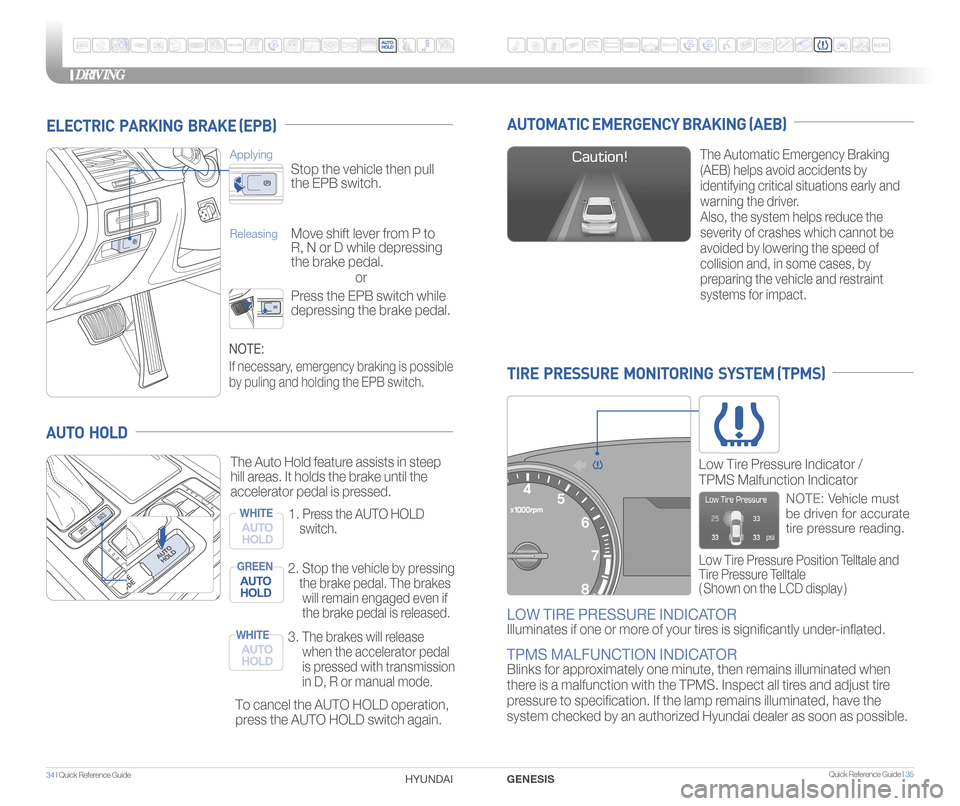
Quick Reference Guide I 35
DRIVING
34 I Quick Reference Guide GENESIS
HYUNDAI
AUTOMATIC EMERGENCY BRAKING (AEB)
The Automatic Emergency Braking
(AEB) helps avoid accidents by
identifying critical situations early and
warning the driver.
Also, the system helps reduce the
severity of crashes which cannot be
avoided by lowering the speed of
collision and, in some cases, by
preparing the vehicle and restraint
systems for impact.
TIRE PRESSURE MONITORING SYSTEM (TPMS)
LOW TIRE PRESSURE INDICATOR
Illuminates if one or more of your tires is significantly under-inflated.
TPMS MALFUNCTION INDICATOR
Blinks for approximately one minute, then remains illuminated when
there is a malfunction with the TPMS. Inspect all tires and adjust tire
pressure to specification. If the lamp remains illuminated, have the
system checked by an authorized Hyundai dealer as soon as possible.
Low Tire Pressure Position Telltale and
Tire Pressure Telltale
( Shown on the LCD display )
Low Tire Pressure Indicator /
TPMS Malfunction Indicator
NOTE: Vehicle must
be driven for accurate
tire pressure reading.
ELECTRIC PARKING BRAKE (EPB)
or
Stop the vehicle then pull
the EPB switch.
Applying
Move shift lever from P to
R, N or D while depressing
the brake pedal.Releasing
Press the EPB switch while
depressing the brake pedal.
NOTE:
If necessary, emergency braking is possible
by puling and holding the EPB switch.
AUTO HOLD
To cancel the AUTO HOLD operation,
press the AUTO HOLD switch again.
The Auto Hold feature assists in steep
hill areas. It holds the brake until the
accelerator pedal is pressed.
1.
Press the AUTO HOLD
switch.WHITE
2. Stop the vehicle by pressing
the brake pedal. The brakes
will remain engaged even if
the brake pedal is released.GREEN
3. The brakes will release
when the accelerator pedal
is pressed with transmission
in D, R or manual mode.WHITE
Page 20 of 22
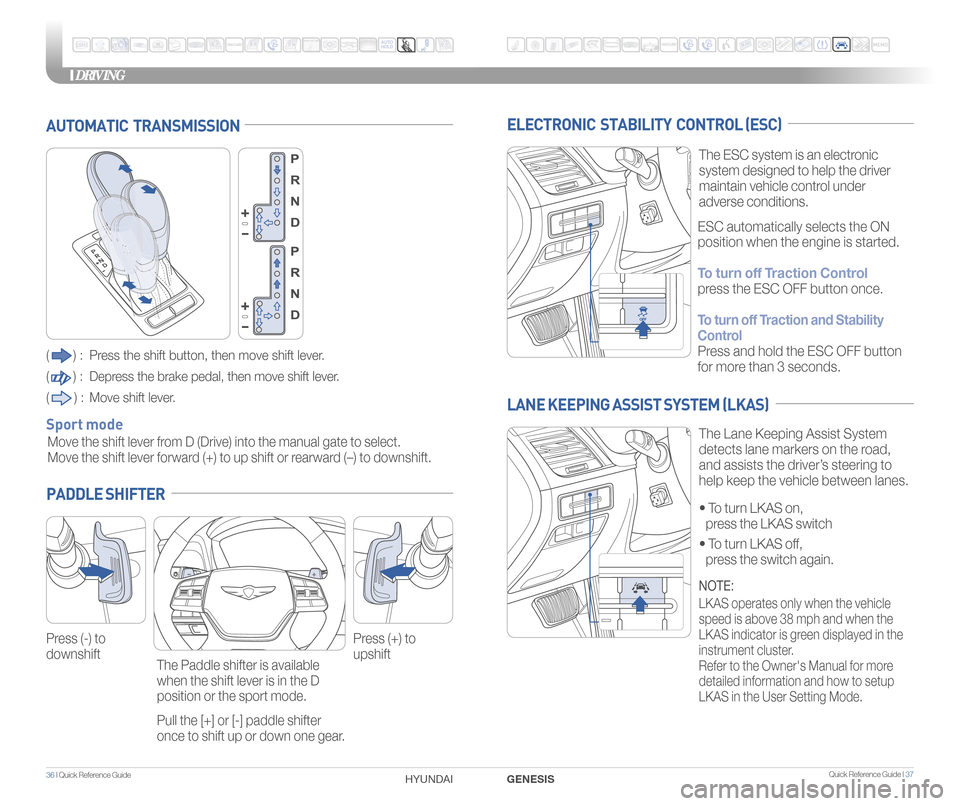
36 I Quick Reference Guide Quick Reference Guide I 37
DRIVING
GENESIS
HYUNDAI
ELECTRONIC STABILITY CONTROL (ESC)
The ESC system is an electronic
system designed to help the driver
maintain vehicle control under
adverse conditions.
• To turn LKAS on,
press the LKAS switch
•
To turn LKAS off,
press the switch again.
The Lane Keeping Assist System
detects lane markers on the road,
and assists the driver’s steering to
help keep the vehicle between lanes.
LANE KEEPING ASSIST SYSTEM (LKAS)
ESC automatically selects the ON
position when the engine is started.
To turn off Traction Control
press the ESC OFF button once.
To turn off Traction and Stability
Control
Press and hold the ESC OFF button
for more than 3 seconds.
NOTE:
LKAS operates only when the vehicle
speed is above 38 mph and when the
LKAS indicator is green displayed in the
instrument cluster.
Refer to the Owner's Manual for more
detailed information and how to setup
LKAS in the User Setting Mode.
AUTOMATIC TRANSMISSION
() : Press the shift button, then move shift lever.
(
) : Depress the brake pedal, then move shift lever.
(
) : Move shift lever.
Move the shift lever from D (Drive) into the manual gate to select.
Move the shift lever forward (+) to up shift or rearward (–) to downshift.
Sport mode
PADDLE SHIFTER
Press (-) to
downshift Press (+) to
upshift
The Paddle shifter is available
when the shift lever is in the D
position or the sport mode.
Pull the [+] or [-] paddle shifter
once to shift up or down one gear.
Page 21 of 22
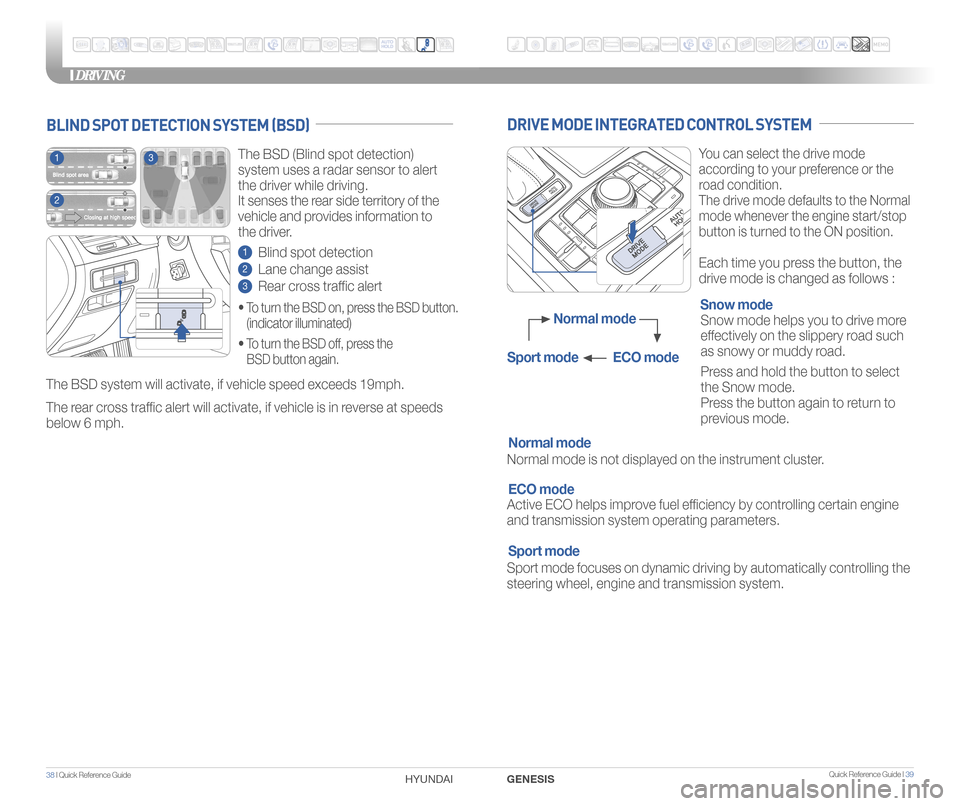
Quick Reference Guide I 3938 I Quick Reference Guide
DRIVING
GENESIS
HYUNDAI
You can select the drive mode
according to your preference or the
road condition.
The drive mode defaults to the Normal
mode whenever the engine start/stop
button is turned to the ON position.
Each time you press the button, the
drive mode is changed as follows :
DRIVE MODE INTEGRATED CONTROL SYSTEM
Normal mode is not displayed on the instrument cluster. Normal mode
Sport mode focuses on dynamic driving by automatically controlling the
steering wheel, engine and transmission system. Sport mode Snow mode helps you to drive more
effectively on the slippery road such
as
snowy or muddy road.
Press and hold the button to select
the Snow mode.
Press the button again to return to
previous mode.
Snow mode
Active ECO helps improve fuel efficiency by controlling certain engine
and transmission system operating parameters. ECO mode
Normal mode
Sport mode ECO mode
The BSD (Blind spot detection)
system uses a radar sensor to alert
the driver while driving.
It senses the rear side territory of the
vehicle and provides information to
the driver.
1 Blind spot detection
2 Lane change assist
3 Rear cross traffic alert
The BSD system will activate, if vehicle speed exceeds 19mph.
The rear cross traffic alert will activate, if vehicle is in reverse at speeds
below 6 mph.
BLIND SPOT DETECTION SYSTEM (BSD)
•
To turn the BSD on, press the BSD button.
(indicator illuminated)
•
To turn the BSD off, press the
BSD button again.
1
2
3